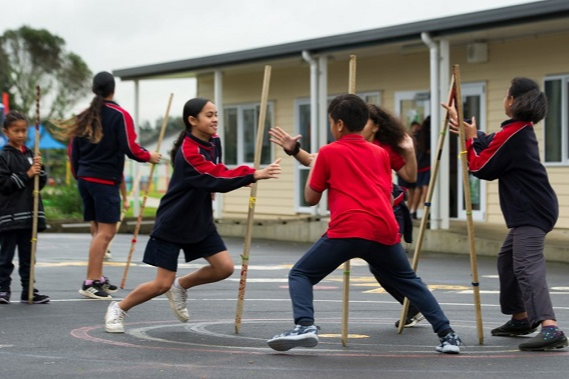Tī rākau - Stick games - Activity collection
This activity collection, "Tī rākau - Stick games", is part of the resource collection Te Ao Kori.

About this resource
This teaching and planning activity collection has instructions that help kaiako support ākonga in playing tī rākau while learning about their whakapapa and tikanga.
Kaiako can adapt and develop activities from the "Tī rākau - Stick games" (years 1–8), which is part of the resource collection, Te Ao Kori, to meet the identified learning needs of ākonga.
Tī rākau - Stick games: Activity collection
Explore the resource collection, Te Ao Kori
This activity resource from "Tī rākau - Stick games" is part of the resource collection Te Ao Kori.
Background information
Te Ao Kori collections
Tātaiako cultural competencies for teachers of Māori learners
Include hapū, iwi, and tangata whenua
Techniques, tikanga, and popular waiata for tī rākau vary between hapū and iwi. Acknowledging mana whenua and the tikanga for tī rākau in your area can begin with conversations and partnerships with ākonga and whānau who bring expertise to the classroom. If you have no Māori whānau, or hapū or iwi connections, within your school, seek introductions to Māori communities through Kāhui ako/school networks, or talk to the strategic advisor Māori at your regional Ministry of Education office.
Whakapapa
Long, long ago, before time began, there was no light in the world, only darkness all around. This was the time of Io the creator, the guardian of the world.
In the quiet of the dark lay Ranginui, the Sky Father, holding the Earth Mother, Papatūānuku, tightly in his arms. Crushed between them in the darkness were their children, all longing for light, space, and freedom.
One of the children was Tāne Mahuta, the guardian and father of the forests. Tāne was big and strong. At last, he could bear to be crowded no longer, and Tāne rose up between his parents and used his great strength to separate them. He thrust Ranginui high, high above Papatūānuku, making sky and earth. Light and air filled the great space between them.
Tāne Mahuta became the father of a great whānau. Two of his children were Harakeke the flax, the child of Pakoti and Raupō, the native bulrush, who was the child of Repo the swamp. Together, Harakeke and Raupō created Poi.
And that is how the first poi was made from the strong leaves of the harakeke flax wrapped tenderly around the soft down of the native bulrush. Today the poi is made of materials of our time, but the story of the poi and its beauty and grace still lives on.
Copyright © The National Heart Foundation of New Zealand 1998.
Tikanga
Tī rākau was traditionally viewed not only as a game and useful exercise for young men, but it was also practised by girls. Young women found that its use was beneficial because it made them active, supple, and improved their agility for performing kapa haka.
Te reo Māori vocabulary
Activities such as those in the Tī rākau collection offer an opportunity to use te reo Māori and appreciate tikanga Māori. Te reo Māori is an intrinsic part of tākaro. Encourage ākonga to use te reo Māori to describe players, places, and movements. In these game contexts, we can use te reo Māori such as:
- Ki raro – down
- Ki runga – up
- Ki te taha – to the side
- Ki waenganui – between
- Kuru(a) – throw
- Matau – right
- Mauī – left
- Me pēnei – like this
- Rau – leaf
- Raupō – bulrush; Typha angustifolia
- Rito – centre shoot or heart of plants, such as flax and cabbage tree
Activities
See below for all resources in the activity collection, “Tī rākau - Stick games".
- Tī rākau/tira: Planning and teaching resources











